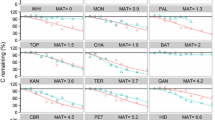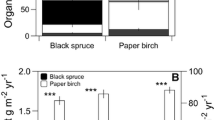Abstract
A model of boreal forest dynamics was adapted to examine the factors controlling carbon and nitrogen cycling in the boreal forests of interior Alaska. Empirical relationships were used to simulate decomposition and nitrogen availability as a function of either substrate quality, the soil thermal regime, or their interactive effects. Test comparisons included black spruce forests growing on permafrost soils and black spruce, birch, and white spruce forests growing on permafrost-free soils. For each forest, simulated above-ground tree biomass, basal area, density, litterfall, moss biomass, and forest floor mass, turnover, thickness, and nitrogen concentration were compared to observed data. No one decay equation simulated forests entirely consistent with observed data, but over the range of upland forest types in interior Alaska, the equation that combined the effects of litter quality and the soil thermal regime simulated forests that were most consistent with observed data. For black spruce growing on permafrost soils, long-term simulated forest dynamics in the absence of fire resulted in unproductive forests with a thick forest floor and low nitrogen mineralization. Fires were an important means to interrupt this sequence and to restart forest succession.
Similar content being viewed by others
References
Aber JD & Melillo JM (1980) Litter decomposition: measuring relative contributions of organic matter and nitrogen to forest soils. Can. J. Bot. 58: 416–421.
Aber JD, Mellilo JM & Federer CA (1982) Predicting the effects of rotation length, harvest intensity, and fertilization on fiber yield from northern hardwood forests in New England. Forest Sci. 28: 31–45.
Auclair AND & Rencz AN (1982) Concentration, mass, and distribution of nutrients in a subarctic Picea mariana-Cladonia alpestris ecosystem. Can. J. For. Res. 12: 947–968.
Berg B (1986) Nutrient release from litter and humus in coniferous forest soils: a mini review. Scand. J. For. Res. 1: 359–369.
Berg B & Staaf H (1980) Decomposition rate and chemical changes in Scots pine needle litter. II. Influence of chemical composition. In: Persson T (Ed) Structure and Function of Northern Coniferous Forests. Ecological Bulletins (Stockholm) 32: 373–390.
Berg B & Staaf H (1981) Leaching, accumulation and release: of nitrogen in decomposing forest litter. In: Clark FE & Rosswall T (Ed) Terrestrial Nitrogen Cycles. Ecological Bulletins (Stockholm) 33: 163–178.
Bonan GB (1988) A simulation model of environmental processes and vegetation patterns in boreal forests: Test case Fairbanks, Alaska. Working paper WP-88-63. Inter. Inst. Appl. Syst. Anal., Laxenburg, Austria.
Bonan GB (1989a) A computer model of the solar radiation, soil moisture, and soil thermal regimes in boreal forests. Ecol. Modelling 45: 275–306.
Bonan GB (1989b) Environmental factors and ecological processes controlling vegetation patterns in boreal forests. Landscape Ecology 3: 111–130.
Bonan GB & Korzuhin MD (1989) Simulation of moss and tree dynamics in the boreal forests of interior Alaska. Vegetatio 84: 31–44.
Bonan GB & Shugart HH (1989) Environmental factors and ecological processes in boreal forests. Annu. Rev. Ecol. Syst. 20: 1–28.
Bonan GB, Shugart HH & Urban DL (1990) The sensitivity of some high-latitude boreal forests to climate parameters. Climatic Change (in press).
Botkin DB, Janak JF & Wallis JR (1972) Some ecological consequences of a computer model of forest growth. J. Ecol. 60: 849–873.
Clayton JL (1976) Nutrient gains to adjacent ecosystems during a forest fire: an evaluation. Forest Sci. 22: 162–166.
Clyde MA & Titus SJ (1987) Radial and longitudinal variation in stem diameter increment of lodgepole pine, white spruce, and black spruce: species and crown class differences. Can. J. For. Res. 17: 1223–1227.
DeBell DS & Ralston CW (1970) Release of nitrogen by burning light forest fuels. Proc. Soil Sci. Soc. Amer. 34: 936–938.
Dubreuil MA & Moore TR (1982) A laboratory study of postfire nutrient redistribution in subarctic spruce-lichen woodlands. Can. J. Bot. 60: 2511–2517.
Dyrness CT & Norum RA (1983) The effects of experimental fires on black spruce forest floors in interior Alaska. Can. J. For. Res. 13: 879–893.
Dyrness CT, Viereck LA & Van Cleve K (1986) Fire in taiga communities of interior Alaska. In: Van Cleve K, Chapin FS, Flanagan PW, Viereck LA & Dyrness CT (Eds) Forest Ecosystems in the Alaskan Taiga (pp 74–86) Springer-Verlag, New York.
Flanagan PW & Van Cleve K (1977) Microbial biomass, respiration, and nutrient cycling in a black spruce taiga ecosystem. In: Lohm U & Persson T (Ed) Soil Organisms as Components of Ecosystems. Ecological Bulletins (Stockholm) 25: 261–273.
Flanagan PW & Van Cleve K (1983) Nutrient cycling in relation to decomposition and organic-matter quality in taiga ecosystems. Can. J. For. Res. 13: 795–817.
Fowells HA (1965) Silvics of forest trees of the United States. USDA, For. Serv. Handbook No. 271. Government Priting Office, Washington, D.C.
Fox JF & Van Cleve K (1983) Relationships between cellulose decomposition, Jenny's k, forest-floor nitrogen, and soil temperature in Alaskan taiga forests. Can. J. For. Res. 13: 789–794.
Hustich I (1951) The lichen woodlands in Labrador and their importance as winter pastures for domesticated reindeer. Acta Geographica 12(1): 1–48.
Hustich I (1954) On forests and tree growth in the Knob Lake area, Quebec-Labrador peninsula. Acta Geographica 13(1): 1–60.
Knight H (1966) Loss of nitrogen from the forest floor by burning. For. Chron. 42: 149–152.
Lewis WM (1974) Effects of fire on nutrient movement in a South Carolina pine forest. Ecology 55: 1120–1127.
Lutz HF (1956) Ecological effects of forest fires in the interior of Alaska. USDA Tech. Bull. No. 1133, Washington, D.C.
MacLean DA & Wein RW (1980) Simulation of wildfire effects on the nitrogen cycle of a Pinus banksiana ecosystem in New Brunswick, Canada. Ecol. Modelling 10: 167–192.
MacLean DA, Woodley SJ, Weber MG & Wein RW (1983) Fire and nutrient cycling. In: Wein RW & MacLean DA (Eds) The Role of Fire in Northern Circumpolar Ecosystems (pp 111–132) John Wiley, New York.
Moore TR (1980) The nutrient status of subarctic woodland soils. Arctic Alp. Res. 12: 147–160.
Moore TR (1981) Controls on the decomposition of organic matter in subarctic spruce-lichen woodland soils. Soil Sci. 131: 107–113.
Moore TR (1984) Litter decomposition in a subarctic spruce-lichen woodland, eastern Canada. Ecology 65: 299–308.
Oechel WC & Van Cleve K (1986) The role of bryophytes in nutrient cycling in the taiga. In: Van Cleve K, Chapin FS, Flanagan PW, Viereck LA & Dyrness CT (Eds) Forest Ecosystems in the Alaskan Taiga (pp 121–137) Springer-Verlag, New York.
Pastor J, Gardner RH, Dale VH & Post WM (1987) Successional changes in nitrogen availability as a potential factor contributing to spruce declines in boreal North America. Can. J. For. Res. 17: 1394–1400.
Pastor J & Post WM (1985) Development of a linked forest productivity-soil carbon and nitrogen model. Technical Manual ORNL/TM-9519. Oak Ridge National Laboratory, Oak Ridge, Tennessee.
Pastor J & Post WM (1986) Influence of climate, soil moisture, and succession on forest carbon and nitrogen cycles. Biogeochemistry 2: 3–27.
Schlentner RL & Van Cleve K (1985) Relationships between CO2 evolution from soil, substrate temperature, and susbtrate moisture in four mature forest types in interior Alaska. Can. J. For. Res. 15: 97–106.
Shugart HH (1984) A Theory of Forest Dynamics. Springer-Verlag, New York.
Shugart HH & West DC (1977) Development of an Appalachian deciduous forest succession model and its application to the impact of the chestnut blight. J. Environ. Manage. 5: 161–179.
Sims HP (1976) The effect of prescribed burning on some physical soil properties of jack pine sites in southeastern Manitoba. Can. J. For. Res. 6: 58–68.
Slaughter CW (1983) Summer shortwave radiation at a subarctic forest site. Can. J. For. Res. 13: 740–746.
Smith DW & Bowes GC (1974) Loss of some elements in fly-ash during old-field burns in southern Ontario. Can. J. Soil. Sci. 54: 215–224.
Smith DW & Sparling JH (1966) The temperatures of surface fires in jack pine barrens. I. The variation in temperature with time. Can. J. Bot. 44: 1285–1292.
Staaf H & Berg B (1982) Accumulation and release of plant nutrients in decomposing Scots pine needle litter. Long-term decomposition in a Scots pine forest. II Can. J. Bot. 60: 1561–1568.
Stoeckeler EG (1952) Investigation of military construction in arctic and subarctic regions: trees of interior Alaska, their significance as soils and permafrost indicators. US Army Corps of Engineers, St. Paul, Minnesota.
Van Cleve K, Barney R & Schlentner R (1981) Evidence of temperature control of production and nutrient cycling in two interior Alaska black spruce ecosystems. Can. J. For. Res. 11: 258–273.
Van Cleve K, Oliver L, Schlentner R, Viereck LA & Dyrness CT (1983a) Productivity and nutrient cycling in taiga forest ecosystems. Can. J. For. Res. 13: 747–766.
Van Cleve K & Viereck LA (1981) Forest succession in relation to nutrient cycling in the boreal forest of Alaska. In: West DC, Shugart HH & Botkin DB (Eds) Forest Succession (pp 185–211) Springer-Verlag, New York.
Van Cleve K, Viereck LA & Dyrness CT (1983b) Dynamics of a black spruce ecosystem in comparison with other forest types: a multi-disciplinary study in interior Alaska. In: Wein RW, Riewe RR & Methven IR (Eds) Resources and Dynamics of the Boreal Zone (pp 148–166) Association of Canadian Universities for Northern Studies, Ottawa.
Van Cleve K & Yarie J (1986) Interaction of temperature, moisture, and soil chemistry in controlling nutrient cycling and ecosystem development in the taiga of Alaska. In: Van Cleve K, Chapin FS, Flanagan PW, Viereck LA & Dyrness CT (Eds) Forest Ecosystems in the Alaskan Taiga (pp 160–) Springer-Verlag, New York.
Viereck LA (1973) Wildfire in the taiga of Alaska. Quat. Res 3: 465–495.
Viereck LA (1983) The effects of fire in black spruce ecosystems of Alaska and northern Canada. In: Wein RW & MacLean DA (Eds) The Role of Fire in Northern Circumpolar Ecosystems (pp 201–220) John Wiley, New York.
Viereck LA, Dyrness CT, Van Cleve K & Foote MJ (1983) Vegetation, soils, and forest productivity in selected forest types in interior Alaska. Can. J. For. Res. 13: 703–720.
Viereck LA & Schandelmeier LA (1980) Effects of fire in Alaska and adjacent Canada: a literature review. Tech. Rep. No. 6. U.S. Dept. Interior, Bureau Land Manage., Alaska.
Viereck LA, Van Cleve K & Dyrness CT (1986) Forest ecosystem distribution in the taiga environment. In: Van Cleve K, Chapin FS, Flanagan PW, Viereck LA & Dyrness CT (Eds) Forest Ecosystems in the Alaskan Taiga (pp 22–43) Springer-Verlag, New York.
Weetman GF (1968) The relationship between feathermoss growth and the nutrition of black spruce. In: Lafleur C & Butler J (Eds) Proceedings of the Third International Peat Conference (pp 366–370) National Research Council of Canada, Ottawa.
Weetman GF & Timmer V (1967) Feathermoss growth and nutrient content under upland black spruce. Woodlands Research Index 183, Pulp Pap. Res. Inst. Can., Pointe Claire.
Yarie J (1983) Forest community classification of the Porcupine River Drainage, interior Alaska, and its application to forest management. US For. Serv. Gen. Tech. Rep. PNW-154.
Zasada JC, Norum RA, Van Veldhuizen RM & Teutsch CE (1983) Artificial regeneration of trees and tall shrubs in experimentally burned upland black spruce/ feathermoss stands in Alaska. Can. J. For. Res. 13: 903–913.
Zoltais SC (1975) Structure of subarctic forests on hummocky permafrost terrain in northwestern Canada. Can. J. For. Res. 5: 1–9.
Author information
Authors and Affiliations
Rights and permissions
About this article
Cite this article
Bonan, G.B. Carbon and nitrogen cycling in North American boreal forests. Biogeochemistry 10, 1–28 (1990). https://doi.org/10.1007/BF00000889
Accepted:
Issue Date:
DOI: https://doi.org/10.1007/BF00000889




